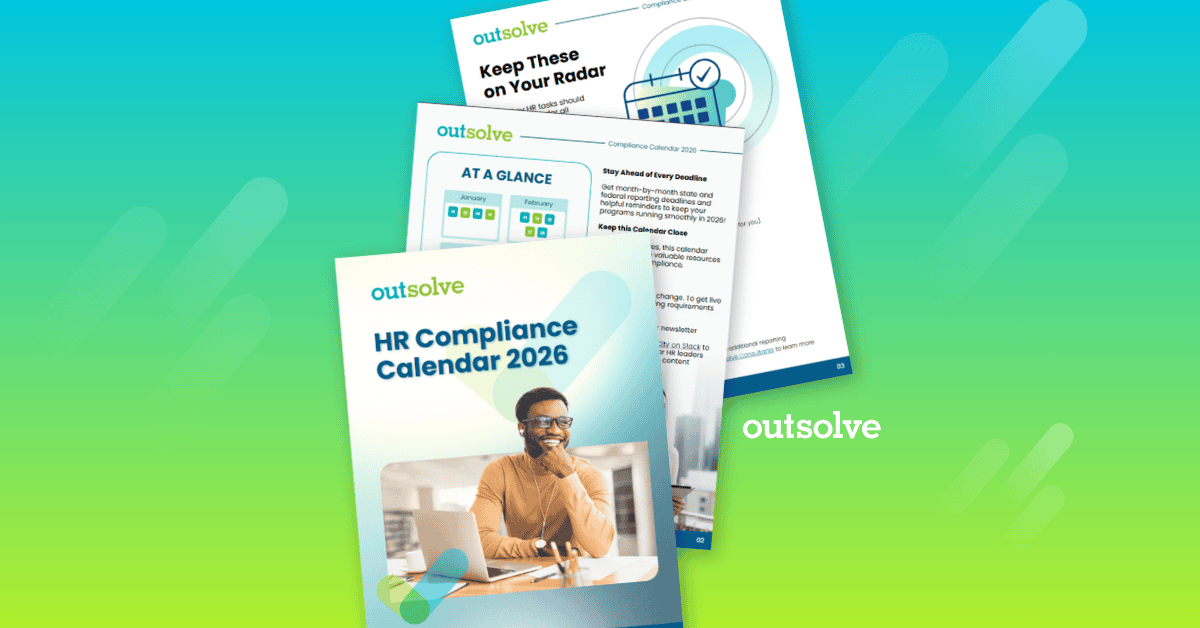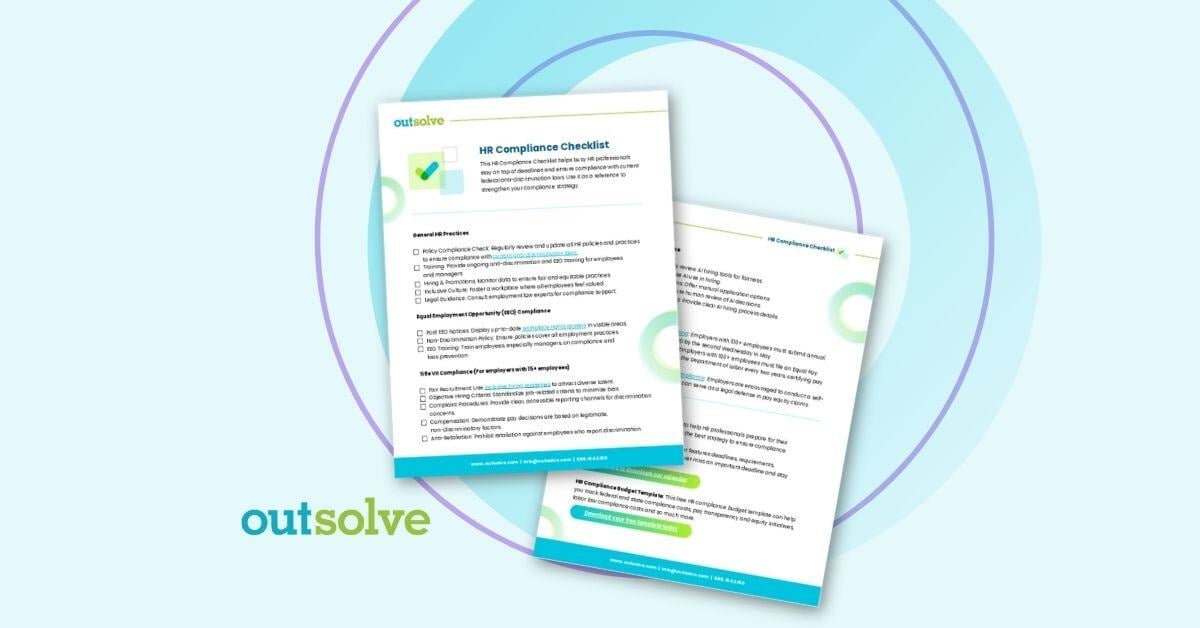
The VETS-4212 Reporting window runs from August 1 through September 30, 2025. Businesses with contacts or subcontracts of $150,000 or greater are required to file this report by September 30, 2025. OutSolve experts can help prepare and file this report for you. Reach out to us today to our consultants today for a smarter, faster way to file.
The VETS-4212 report is an important way to illustrate your company's commitment to hiring and retaining veterans. This report is more than just a box to check, it reflects compliance with the Vietnam Era Veterans' Readjustment Assistance Act (VEVRAA) and supports broader efforts to build a diverse and inclusive workforce, which is becoming increasingly critical during this chaotic time in HR Compliance.
VETS-4212 is a key compliance requirement for federal contractors, focused on the accurate representation of veteran hiring efforts. Whether you’re familiar with the process or just starting to understand it, this guide to the VETS-4212 filing requirements, its significance, and how to complete it accurately and efficiently will give you what you need to know. And, if you are looking to offload this task, OutSolve can become your HR partner and take over the responsibility of preparing and submitting this oftentimes complex report.
What is the VETS-4212 Report?
The VETS-4212 report is a compliance tool created by the U.S. Department of Labor (DOL) to track the employment of veterans by federal contractors. This report is vital for ensuring that federal contractors are meeting their obligations under VEVRAA and requires contractors and subcontractors to report annually on the number of veterans they employ, categorized by different veteran status groups, including disabled veterans, recently separated veterans, and others.
The Purpose and Legal Background of VETS-4212
The purpose of the VETS-4212 report is to help the government monitor and promote equal employment opportunities for veterans. Federal contractors must follow regulations that encourage hiring veterans as part of the effort to support veterans' rights and the integration into the civilian workforce. The legal basis for this reporting requirement is primarily grounded in VEVRAA, which mandates that contractors take affirmative action to employ, and advance in employment, qualified veterans.
Why The VETS-4212 Report Matters
The VETS-4212 report serves several important purposes:
- Tracking Progress: It allows the government to track the progress federal contractors are making toward their veteran hiring goals.
- Accountability: By requiring detailed information about veteran employment, it holds contractors accountable for their commitment to hiring veterans.
- Compliance: Failing to file the VETS-4212 report or submitting inaccurate information can result in penalties or even loss of federal contracts, making compliance critical for businesses relying on government contracts.
Who Needs to File the VETS-4212 Report?
Not all businesses are required to file the Form VETS-4212. Federal contractors and subcontractors that meet the following specific criteria must submit the report each year:
- Have a federal contract or subcontract of $150,000 or more, regardless of the number of employees.
- Are subject to the affirmative action provisions of VEVRAA.
If your company meets the above criteria, then you are required to file the report annually, even if you have no veteran employees to report. This allows the federal government to monitor and keep track of veteran employment.
VETS-4212 Filing Requirements
The VETS-4212 filing requirements are straightforward but must be followed carefully to remain in compliance. Here are the requirements:
- Employment Categories: You must report the number of employees in specific EEO job categories, such as:
- Executive/Administrative
- Professionals
- Technicians
- Sales workers
- Office and clerical
- Craft workers
- Laborers
- Service workers
- Veteran Hiring Details: You are required to disclose the number of veterans employed within these categories, including:
- Disabled veterans: Veterans with disabilities incurred or aggravated during military service.
- Recently separated veterans: Veterans who were discharged within the past three years.
- Active-Duty Wartime or Campaign Badge Veteran: Veterans who serve on active duty during the war earn campaign badges.
- Armed Forces Service Medal Veteran: Veterans who were awarded a medal for U.S. Military operation while they were on active duty as defined in Executive Order 12985.
- To assist your applicants and workforce understand if they are a Protected Veteran, download the “Am I A Protected Veteran?” Infographic Poster
- Data Accuracy: The data must be complete and accurate. This includes ensuring that all employment data is categorized correctly and accurately reflects the status of veterans. Data accuracy is a critical step in the process, so the data is not “garbage in, garbage out.” Contractors are responsible for making sure their data is correct.
- Submission Process and Deadlines: The VETS-4212 filing period is typically between August 1st and September 30th each year. Contractors must ensure that the report is filed online using the VETS-4212 submission portal provided by the Department of Labor. Contractors can also choose to partner with an HR consultant firm like OutSolve to complete this report for them, ensuring accurate and timely submission.
Common Compliance Mistakes and How to Avoid Them
Filing the VETS-4212 form can be straightforward if you understand the requirements. However, there are a few common mistakes that HR professionals often make when completing the report.
- Late Filing Penalties: One of the biggest risks for federal contractors is missing the filing deadline. The VETS-4212 deadline is strict, and late submissions can result in penalties. Depending on the severity, these penalties can range from fines to the loss of eligibility for future contracts. Be sure to set reminders well in advance of the deadline and ensure all necessary data is ready to submit.
- Incomplete or Incorrect Data: Another frequent issue is incomplete or incorrect data. Providing inaccurate veteran employment data can trigger audits and potential penalties. Be careful in categorizing veterans correctly and double-check your employee counts in each category. If you’re unsure, seek guidance from OutSolve.
How to File a VETS-4212 Report
The VETS-4212 report is filed online through the Department of Labor’s VETS-4212 portal. Here’s a brief overview of the filing process:
- Login to the Portal: You’ll need to create an account on the VETS-4212 submission website if you don’t have one already.
- Gather Employment Data: Ensure that you have all the necessary data related to veteran hires and their employment categories.
- Complete the Form: Fill out the form with the required employment and veteran hiring details.
- Submit: After reviewing the form for accuracy, submit the form to the Department of Labor by September 30.
While the process itself is relatively simple, the need for accuracy and attention to detail cannot be overstated. For HR, this can be time-consuming, especially when managing other compliance duties. That’s where outsourcing the process can be invaluable.
Why Outsource Your VETS-4212 Filing?
Many federal contractors find that outsourcing their VETS-4212 filing to a professional HR consulting firm, such as OutSolve, is the best option. Here’s why:
- Expertise: Professionals at OutSolve specialize in compliance and can make sure your report is accurate and filed on time. They stay up to date with the latest regulations and requirements, so you don’t have to.
- Time Savings: Outsourcing the process frees up valuable time for your HR team to focus on other priorities, leaving the report to the experts who will handle the compliance aspects.
- Minimize Risk: Outsourcing can help avoid common mistakes, such as incorrect data or missed deadlines, which could lead to penalties or audits. OutSolve knows the report in and out and will make sure every nuance is covered.
- Comprehensive Support: OutSolve doesn’t just file your report, they provide ongoing compliance support that can help your company with any related HR needs.
Helpful Resources for Compliance
For those who prefer to handle the filing in-house, several resources can help ensure compliance, such as:
- Department of Labor VETS-4212 Website: The DOL’s website provides up-to-date information about the filing process, deadlines, and instructions for completing the report.
- Compliance Guides: OutSolve offers resources that provide detailed instructions and best practices for completing the VETS-4212 report.
Final Tips & Best Practices
Here are some additional tips to help you stay on top of your VETS-4212 compliance:
- Leverage Technology: There are several software solutions available (HRIS and ATS) that can streamline the VETS-4212 filing process, ensuring accuracy and efficiency.
- Regularly Review Employment Data: Keep track of your veteran hiring efforts throughout the year, so you’re not scrambling to gather data at the last minute.
- Consult an Expert: Reach out to OutSolve for full assistance with VETS-4212.
What Filing the VETS-4212 Report Means for Your Organization
The VETS-4212 report is an essential part of compliance for federal contractors, ensuring that the government can track progress when it comes to hiring veterans. By understanding the filing requirements, common mistakes, and leveraging technology or outsourcing the report, HR can make sure that they meet their obligations and avoid potential penalties.
If you want to ensure your VETS-4212 compliance report is handled accurately and smoothly, please reach out to the experts at OutSolve today. Their knowledge and experience in the field can help you navigate the federal contractor reporting process. Don’t risk missing the VETS-4212 deadline – let us handle it for you!
Hector Peguero has over 20 years of experience in Customer Service and consulting. He’s passionate about helping clients navigate the world of non-discrimination and VETS-4212 reporting, as Outsolve’s Subject Matter Expert (SME) on VETS-4212 reporting. Hector holds a Master’s degree from la Universidad Autónoma de Barcelona.
Weekly OutLook
Featured Posts

New Year, New Deadlines: 2026 HR Compliance Calendar

outRageous HR: Plan Now or Pay Later
Related Posts

Refreshing Your I-9 Tools and Process to Stay Compliant
Form I-9 is a federal requirement that carries real consequences if handled improperly. With increased scrutiny on immigration by the current...
.png)
New Year, New Risk: Why Federal Contractors Can’t Hit Snooze
Lean in to disciplined, data‑driven compliance

An HR Year in Review: Key Updates in 2025
The unpredictability of 2025 has been an uphill trek for HR teams across the U.S. This year brought substantive employment compliance changes to...
 Hector Peguero
Hector Peguero

